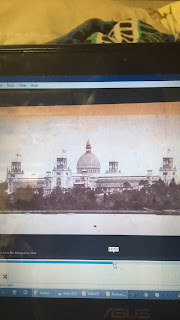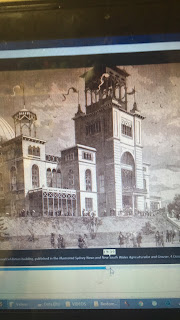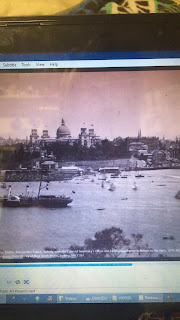Sydney Garden Palace Part 6
Search This Blog
Monday, November 12, 2018
Friday, September 30, 2016
Tuesday, March 29, 2016
Construction Of The Sydney Garden Palace
THE CONSTRUCTION OF THE SYDNEY GARDEN PALACE
JANUARY 13th 1878 - SEPTEMBER 23rd 1878
The Building was Finally Finished Less than 3 weeks Before the Grand Opening Of The International Exhibition Which Would Showcase Colonies To The World.
The Previous International Exhibition Had Been Held In Paris and The Eiffel Tower Had Been
Built As The Modern Wonder Of It’s Time. Sydney Had To Outdo The Eiffel Tower And So It Had Been Decided That The Grandest Palace Should Be Built At The Botanical Gardens.
Every Suburb In SYDNEY Could See The Palace No
matter What Suburb You Were in. It Was The Tallest Building
Ever Built In SYdney And It Is Definately The Grandest Building
Ever Built In Australia:
There Is No Other Building That Has Been Built In This
Country Or Attenpted To Be Built.
It Was Truly The Envy Of The Modern World
Over 1.6 Million People Sailed To SYDNEY From September 1878 Till December 1878
The First Sod Was Turned on The 13th January 1878 For The Construction Of The SYDNEY GARDEN PALACE.
6,000 Tradesmen Worked 24 Hours A Day 7 Days A Week For 8 Months. It Was The First Time Electricty Had Been Used In Australia to Light up the Botanical Gardens To get The Work Done.
- 4 And A Half Million Feet Of Timber - 25 Million Bricks - 400 Tonnes Of Glass - 54km Of Roof Guttering- The Palace Was The very First Building To Have Electricity In Australia. - It Was The First Building In Australia To Have A Hydraulic Lift. - The Central Dome Was The 6th Biggest In The World- 2,300 Cast Iron Girders- 358 Wrought Iron Trusses- 325km Of Sash Bars- 563 Metres Long And 124 Metres Wide
On the morning of September 22, 1882, Sydney awoke to a grand and terrible spectacle. Its most flamboyant building, the garden palace was burning to the ground
The heat was so intense at 6:05 am, Windows at Macquarie Street cracked & firefighters could do little more than watch the building turn into cinders.
The fire was a magnificent as a pallet its self-thunderous crashes rivers of lead and when the walls fell away a terrible vision of flames and golf in the towering bronze statue of Queen Victoria
By 9 am it was all over and the building had that had dominated the city skyline for three years was gone.
Despite being One of the most captivating buildings Sydney has ever seen, the garden palace is largely absent from popular history of my Sydneysiders have never heard of it.
Because building is stretching from the State library to the Conservatorium of music in the botanic Gardens, it’s towers and 65 meter high dome would have dwarfed the buildings around it.
The site is difficult for most people to conceive and the fact that it was the length of two football fields and in the botanic Gardens of all places within the city of this size was such a luxury.
Modelled on London’s Crystal Palace, it was purpose-built for the 1879 Sydney international exhibition & was designed by colonial architect James Barnett.
It was responsible for bringing the world to Sydney at a time when the colony was prosperous & growing & at full potential. It encouraged authorities to improve the city services and facilities
International exhibition was groundbreaking in so far as it was the first of its kind to be held in the southern hemisphere.
The Victorian equivalent of the world expo, exhibitions in Welfare‘s were at the height of fashion at the time
The feeling in the city would’ve been similar to that of the Olympics in 2000. It was very positive thing for Sydney and New South Wales, & an event to be celebrated. The city would’ve been buzzing in a hive of activity
For seven months, more than 1 million people pulled into the sprawling complex to marvel at the buildings of city prosperity
But 20 ha of the botanic Gardens became a Fairground filled with band stands, stalls, entertainment, eateries & small exhibition buildings.
The garden palace was a centrepiece & inside, all manners of inventions, technology, art & ideologies were displayed by local and international exhibitors.
Sydney had pulled out all stops to build a palace & had raced against time to beat Melbourne, which was also staging an exhibition.
Over 2000 men worked on on the site night & day, using electric light for the first time, to complete the building in just eight months.
The city was plagued with insecurities in the lead up to the event, with concerns about whether it’s public transport, accommodation & water supply would be adequate for all visitors travelling to the infant city.
It was forced to install a line for steam a tram, a first for Sydney and an unpopular idea at the time after previous tram efforts resulted in the death of prominent position in 1864
The steam power Tramway was installed to public transport exhibition goes around the city. After the exhibition, the Tramway network was expanded and by 1905 - 1906 the trams were converted to electric traction
Despite several accidents, it was a great success & the system expanded rapidly through the city and in the suburbs. It became one of the main attractions of the exhibition.
After the exhibition, the palace continued to play a central role in Sydney social life. Balls, lectures, exhibitions and entertainment were hosted in its auditorium; an art gallery and the first technological museum, the forerunner to the powerhouse Museum were on the list.
Government departments also set up office and important records were stored in the basement, the wisdom of which would later be questioned. That’s because unlike Barnett’s other sturdy designs such as the GPO, the colonial secretaries office and the lands department building which still stand today, the palace was primarily made of timber, which insured its complete destruction when it was engolfed by fire.
While arson was generally suspected, the cause of the fire was never determined and remains a mystery to this day.
The blaze, which began before 6 am, became almost immediately uncontrollable and thousands lined the streets to witness the calamity.
Very quiet and orderly the thousands looked on - wrote one reporter in the evening news
Many will lamenting ®retting the inevitable destruction of what’s given them so much pleasure, and have carried the name and doings of the people of this country into the empires and other countries.
The wind carried ash, cinders and fragments of the building far into the suburbs and a house in Potts point caught fire.
Almost everything inside went up in flames. The fire destroyed the 1881 census, the land occupation records, railway surveys, aboriginal artefacts, artworks & the foundation collection of the technological & mining Museum.
A new map of the colony which took years of work was also lost.
Conspiracy theories from dynamite plots, masked man and trains of gunpowder were banded around afterwards. Wealthy folk with lame for trying to restore harbour views, destroy convict Ancestry or simply get their gardens back.
Whatever the cause thousands came to view the ruins & the police were on site to keep order.
To leave such a beautiful building that was such a positivity to the city and one that was so new as well would’ve been quite shocking
Some items and artefacts are irreplaceable, however we do know that insure trade Australian spirit almost before the Coles cool Joseph maiden, first curator of the technological museum, said about forming another collection of artefacts by approaching people who had donated items in the original museum collection.
Today, all that is left of the palace other than sandstone gates and the wrought iron gates on the Maxquarie Street entrance to the gardens
In 1940s or something garden in Fountain featuring statue of Cupid Marks the former location of the palace is Dome
Thursday, October 8, 2015
Sydney Garden Palace - Part 2
Sydney Garden Palace - Part 2
There are a few photos of the Crystal palace Located at the Royal Botanic Gardens in Sydney Australia. This magnificent structure was built to hole the World Expo in the 1880's. Unfortunately within a couple years of it being built, it burnt down.
It appears to be one of the most magnificent buildings in Sydney for the time, far outweighing the Queen Victroria building etc and other buildings in Sydney of that era. There are only a few photos left.
the Palace was composed almost entirely of iron and glass with wood used only in the fittings and floorboards. The construction used 2300 cast-iron girders, 358 wrought-iron trusses to support the roof, 325 kilometres of sash bars supporting glass weighing more than 406 tonnes and 3230 hollow cast-iron columns which, as well as being the primary supporting infrastructure, served as water pipes to carry off rainwater from the 54.7 kilometres of guttering.
The final structure was an impressive 563 metres long and 124 metres wide with a central transept 22 metres wide and rising to 32.9 metres, specially designed to enclose within the building a grove of tall elms that public opinion would not allow to be cut down. The structure covered over seven hectares of ground and enclosed 934 560 cubic metres of space while galleries added another two hectares to the floor area.
If opening day was a sensation the following weeks exceeded all expectations. Carried from the Midlands and the North by the newly inaugurated popular excursion trains and coastal steamers, visitors to the Exhibition came in numbers that first alarmed, then surprised and finally delighted the organisers. Men, women and children came, they came singly, they came in families, they came, in the end, in droves. On one day in October 109 915 people were admitted to the Exhibition.
Other statistics add to the legend of the Exhibition. It attracted no fewer than six million visitors during the 141 days it was open to the public—many from overseas; an incredible number considering a population much lower, and poorer, than today, and limited transport options—no international flights or coach tours! The Exhibition also achieved several other firsts, including the first public toilets—which brought in a substantial contribution of £1769 to the overall profit of £186 000—and it was the first, and possibly the last, to actually make a profit, part of which was used to provide London with a cultural and educational centre, including the famous Victoria and Albert Museum. The total value of the exhibits was estimated at about £2 million—not including the fantastic Koh-i-Noor (Mountain of Light) diamond, now part of the British crown jewels, and which was considered too difficult to value. The figures clearly show the Great Exhibition in its spectacular Palace was a resounding triumph.
Not surprisingly, the phenomenal success encouraged international emulation and the rest of the world quickly followed suit. Australia’s first international trade exhibition opened in Sydney in 1879. It was housed in a specially constructed large and ornate building called the Garden Palace on land now included in the Botanic Gardens. Unhappily it was destroyed by fire in 1882


































